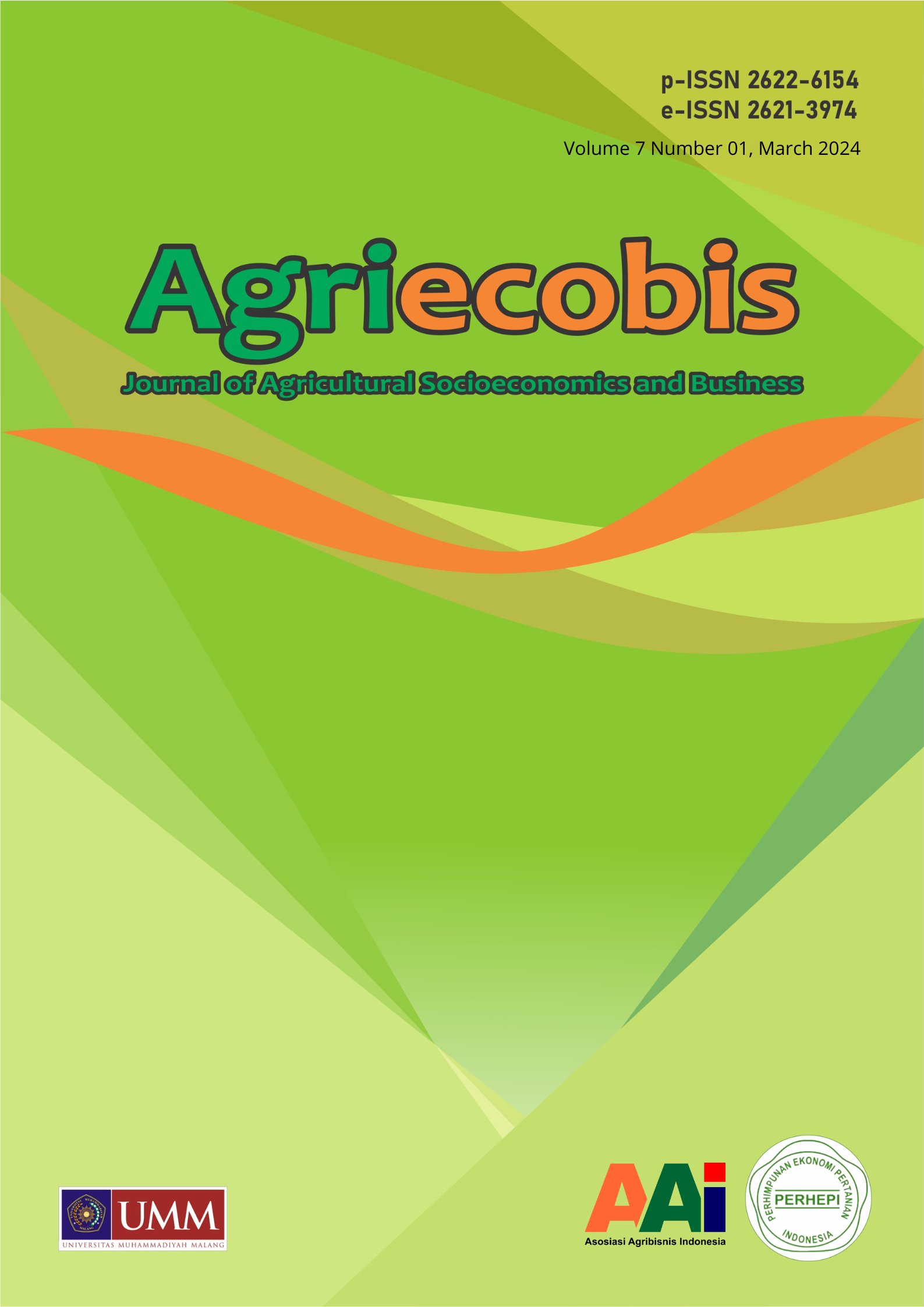Human Resource Development Strategy in the Beef Industry at CV Sakha Muria, Depok, West Java, Indonesia
DOI:
https://doi.org/10.22219/agriecobis.v7i01.31304Keywords:
Beef, Development, Human Resource, blue ocean strategyAbstract
CV Sakha Muria, a beef distribution enterprise, has established a robust presence across Java. This research endeavors to delineate and scrutinize the principal determinants of the company, as well as to delineate priority strategies. Employing a descriptive method with a mixed-method approach, primary data was gathered through interviews and questionnaires, supplemented by secondary data extracted from pertinent academic journals and BPS datasets. Purposive sampling was employed, with a sample size of 19 individuals. Data analysis entailed the utilization of the Internal Factors Evaluation (IFE) Matrix, External Factors Evaluation (EFE) Matrix, Internal-External (IE) Matrix, SWOT Matrix, and QSPM Matrix. Findings indicate that the primary internal factor facilitating the work process of employees is the company's facilities, scoring 0.63, while the predominant external factor is the establishment of robust inter-company cooperation, scoring 0.61. The IE Matrix positions the company at V (2.95, 2.93), suggesting a stance of preservation and maintenance. SWOT analysis reveals the company's commitment to skill development, recruitment of technologically literate and highly motivated employees, and ongoing enhancements to the compensation system to sustain employee attraction. Additionally, the company entrusts experienced personnel with supervisory roles, establishes specialized teams to monitor regulatory changes, and mitigate their impact on employee management costs and procedures. The prioritized strategy, as per the QSPM Matrix with a value of STAS (6.95), underscores the imperative of enhancing employee skills in alignment with market dynamics and adapting to regulatory shifts or policy changes.
Downloads
References
Anderson. C.. dan Brown. D. (2022). The Impact of Employee Skills Alignment on Organization Success. Journal of Human Resource Management. 30(1). 45–62.
Anderson. C.. dan Johnson. D. (2022). The Impact of Effective Inter-Company Collaboration on Business Success. Journal of Business Partnerships. 14(3). 45–60.
BPS. (2019). Distribusi Perdagangan Komoditas Daging Sapi di Indonesia 2019 (M. Karmiati. R. Suerlianto. dan R. R. Sood. Ed.). BPS-Statistic Indonesia.
BPS. (2022). Produksi Daging Ternak Kota Depok 2020-2022.
David. F.. dan David. F. (2016). Manajemen Strategik: Suatu Pendekatan Keunggulan Bersaing (15 ed.). Salemba Empat. Jakarta
Ibrahim. M. (2022). Mitigasi Risiko Rantai Pasok Daging Sapi di PT Gizi Pangan Utama Bekasi [Skripsi]. Universitas Islam Negeri Syarif Hidayatullah Jakarta. Jakarta.
Johnson. C.. dan Williams. D. (2022). The Strategic Value of Experienced Employees in Meeting High Labor Market Demand. Human Resource Management Review. 30(4). 567–584.
Jones. A.. dan Smith. B. (2021). Enhancing Employee Performance through Advanced Workplace Infrastructure. Journal of Organization Excellence. 25(2). 123–140.
Khurotin. N. (2018). Analisis Pelatihan dan Pengembangan Sumber Daya Manusia di PT Beon Intermedia Cabang Malang. Universitas Brawijaya. Malang.
Nikmah. K.. dan Pratama. A. (2023). Pengembangan Standar Operasional Prosedur (SOP) Pada Bagian Keuangan PT XYZ. Bisnis dan Akuntansi (JEBA). 25(1). 10–18.
Ningrum. H. F.. Iskandar. Y.. dan Akbar. B. M. B. (2020). Strategi Pengembangan Sumber Daya Manusia Untuk Meningkatkan Kinerja Karyawan Di PT XYZ. JIMEA: Jurnal Ilmiah MEA (Manajemen. Ekonomi. dan Akuntansi). 4(3). 74–83.
Onsardi. (2020). Manajemen Sumber Daya Manusia. Modul Kuliah MSDM International. 1–50. Universitas Suryadarma. Jakarta.
Patel. C.. dan Sharma. R. (2020). Examining the Impact of Employee Attention to Detail on Work Performance. Journal of Workplace Psychology. 15(3). 45–60.
Patel. C.. dan Sharma. R. (2022). Building Consumer Trust Strategies and Implications. International Journal of Business and Management. 30(4). 215–230.
Permana. A.. dan Wibowo. A. (2022). Dampak Ketidakstabilan Ekonomi terhadap Stabilitas Pekerjaan dan Kompensasi Karyawan: Studi Kasus di Indonesia. Jurnal Ekonomi dan Bisnis. 10(2). 45–60.
Ramang. A. (2021). Strategi Pemasaran Daging Sapi Di CV. Awal Putra MA Rangga Malili. Universitas Hasanuddin. Makassar.
Sugiyono. (2015). Metode Penelitian Kuantitatif. Kualitatif dan R dan D (22 ed.). Alfabeta. Bandung.
Sunarsi. D. (2019). Seminar Sumber Daya Manusia (F. Septiani. Ed.; 1 ed.). Unpam Press. Universitas Pamulang. Tangerang Selatan.
Susanto. B.. dan Utomo. D. (2022). Pemanfaatan Alat Kolaborasi Digital dalam Meningkatkan Produktivitas Kerja Suatu Tinjauan di Lingkungan Perusahaan. Jurnal Inovasi Bisnis dan Manajemen. 8(1). 45–60.
Umam. K.. dan Atho’illah. A. Y. (2021). Strategi Pengembangan Sumber Daya Manusia Karyawan Commanditaire Vennootschap Dalam Meningkatkan efektivitas Kinerjanya. MANOVA. 4(1). 68–83.
Wahyunawati. S. (2023). Penggunaan Matriks SWOT dan QSPM dalam Menentukan Strategi Pengembangan Kompetensi Karyawan PT Ketapang Subur Lestari. MAMEN. 2(1). 44–59.
Yesabella. T.. dan Nugroho. B. (2023). Pengaruh Kepuasan Kerja. Keadilan Prosedural dan Kompensasi Terhadap Kinerja Karyawan di PT Bengawan Solo Trans. Jurnal Ekonomi dan Kewirausahaan. 23(1). 34–41.
Published
How to Cite
Issue
Section
License
Copyright (c) 2024 Agriecobis : Journal of Agricultural Socioeconomics and Business

This work is licensed under a Creative Commons Attribution-ShareAlike 4.0 International License.
Authors who publish with Agriecobis : Journal of Agricultural Socioeconomics and Business agree to the following terms:
- For all articles published in Agriecobis : Journal of Agricultural Socioeconomics and Business, copyright is retained by the authors. Authors give permission to the publisher to announce the work with conditions. When the manuscript is accepted for publication, the authors agree to automatic transfer of the publishing right to the publisher.
- Authors retain copyright and grant the journal right of first publication with the work simultaneously licensed under a Creative Commons Attribution-ShareAlike 4.0 International License that allows others to share the work with an acknowledgment of the work's authorship and initial publication in this journal.
- Authors are able to enter into separate, additional contractual arrangements for the non-exclusive distribution of the journal's published version of the work (e.g., post it to an institutional repository or publish it in a book), with an acknowledgment of its initial publication in this journal.
- Authors are permitted and encouraged to post their work online (e.g., in institutional repositories or on their website) prior to and during the submission process, as it can lead to productive exchanges, as well as earlier and greater citation of published wor (See The Effect of Open Access).

This work is licensed under a Creative Commons Attribution-ShareAlike 4.0 International License.







